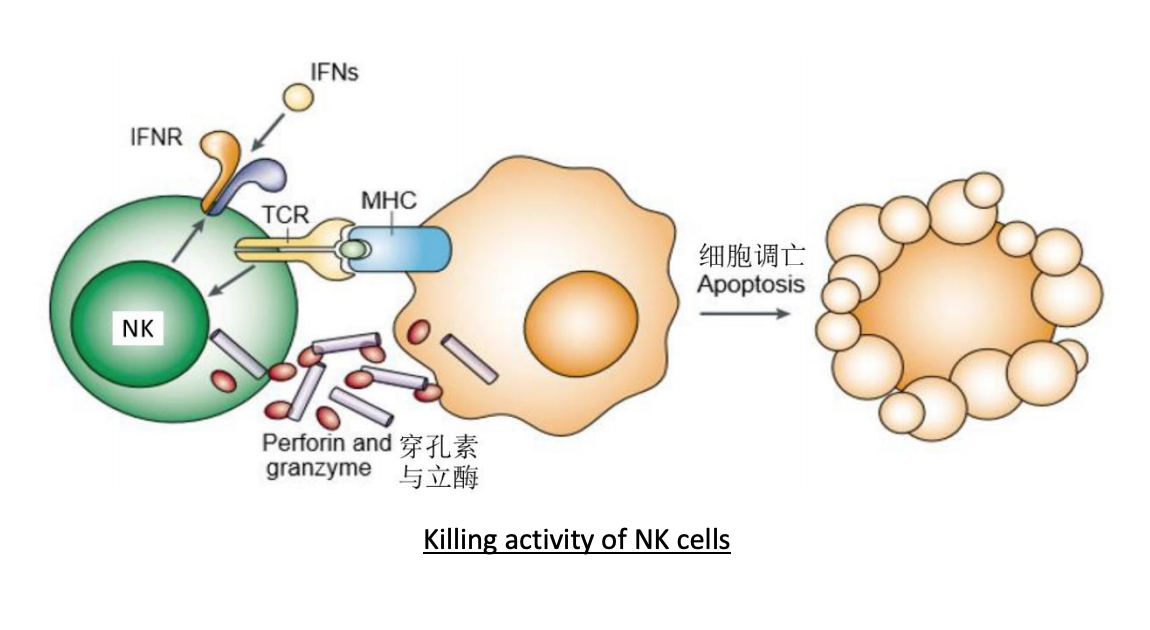1) Natural killer cells (NK)
Natural killer cells (NK) are important immune cells in the body that function as an anti-tumor, anti-viral infection and immune regulation as well as participating in hypersensitivity and autoimmune diseases functions.
The origin source of NK cells is not well understood and is generally thought to be derived directly from the bone marrow, which is dependent on the microenvironment of the bone marrow. In vitro experiments in mice and humans have shown that lymocytes can also induce NK cells by culturing in the presence of IL-2 and other cytokines in vitro. Mouse spleen can promote the differentiation of NK cells induced by IL-3 in vivo. NK cells are mainly distributed in peripheral blood, accounting for 5- 10% of PBMC. There are also NK activities in lymph nodes and bone marrow, but at a level lower than that of peripheral blood.
The specificity of NK cell surface markers is relative to T cells and B cells. Human NK cells mIg-, part of NK cells positive for CD2, CD3 and CD8, express IL-2 receptor β chain (P75, CD122), CD11b/CD18 positive. Commonly used markers for detecting NK cells are CD16, CD56, CD57, CD59, CD11b, CD94 and LAK-1. Study have been demonstrated that NK cells have partial T cell differentiation antigens, such as 80~90% NK cells CD2+, 20~30% NK cells CD3+ (expressing CD3 δ chain), 30% NK cells CD8+ (α/α) and 75~90% NK cells CD38+. Since, NK cells have IL-2 receptor, therefore, NK proliferation can be stimulated by IL-2, and activated NK cells can secrete cytokine IFN-γ, hence, NK cells are considered to be more closely related to T cells.
Interested in learning more about NK cells and their role in the immune system? Contact us for in-depth information and professional insights
2) Recognition of NK cell to target cell
Since the killing activity of NK cells is not restricted by MHC and is not dependent on antibodies, it is called natural killing activity. Cytoplasm of NK cells contain large azurophilic granules that have spontaneous cytotoxicity against a variety of tumor cells, virus-infected cells, and some normal cells in the bone marrow and thymus.
Identifying target cells NK cells recognize that target cells are non-specific, however, it is unclear that how the NK cell recognize a target cells. It is plausible that lymphocyte function-associated antigen-1 (LFA-1) interacts with the intercellular adhesion molecule-1 (ICAM-1) on the surface of target cells to participate in the recognition process of NK cells. In addition, binding of CD2 to LFA-3 (CD58) and CD56 may also mediate binding of NK cells to target cells.
Have questions about NK cell recognition processes? Our experts are here to provide the answers. Get in touch with us today!
3) Mechanism of cytotoxic effect of NK cell
(1) NK cell contain perforin. Perforin is a pore-forming protein that leads to osmotic lysis of the target cells and subsequently enables granzymes to enter the target cells and activate apoptosis, the cell death program.
(2) NK cytotoxic factor: NK cells can release soluble NK cytotoxic factor (NKCF), and NKCF receptor is on the surface of target cells. NKCF can selectively kill and lyse target cells after binding to target cells.
(3) Tumour necrosis factor (TNF): activated NK cells can release TNF-α and TNF-β (LT), TNF can change the stability of target cell through lysosome and lead to leakage of various hydrolase; affect cell membrane phospholipid metabolism; change target cells Glucose metabolism reduces the pH in the tissue and activates the target cell endonuclease, degrades the genomic DNA to cause programmed cell death and other mechanisms to kill the target cells. The process of TNF-induced cell death is significantly slower than that of perforin-dissolving cells.
(4) Secreted cytokines: Activated NK cells can synthesize and secrete a variety of
cytokines, play a role in regulating immune and hematopoietic effects and directly killing target cells.
For more click here.
For a deeper dive into the cytotoxic mechanisms of NK cells and their therapeutic potential, reach out to our team for detailed discussions and professional guidance.



